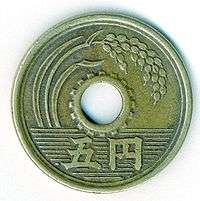10 sen coin
The 10 sen coin (十銭硬貨) was a Japanese coin worth one tenth of a Japanese yen, as 100 sen equalled 1 yen.[1] These coins were minted from the late 19th century up until the end of World War II.
Japan | |
| Value | 1⁄10 Japanese Yen |
|---|---|
| Shape | circular |
| Composition | Several different metals |
| Years of minting | 1870–1946 |
| Obverse | |
| Design | Various, depending on year. |
| Reverse | |
| Design | Various, depending on year. |
History
Ten sen coins were first minted in 1870, and like the other sen coins were made for international convenience. The Japanese government bought a mint in Hong Kong, and the machinery was established in Osaka. In The British Almanac from 1873, author John Crowdy notes that the Japanese put a lot more thought into convenience than the German Empire.[2] These coins were minted during eight periods that spanned three different imperial eras. Two different varieties were produced in 1940, 1941, and 1943 when the coin was ultimately reduced in size. At the end of World War II, aluminium coins were produced from late 1945 into 1946. The final ten-sen coins were produced in 1946, and were eventually taken out of circulation at the end of 1953.[3]
Composition
| Years | Material |
|---|---|
| 1870–1906[4][5] | 80% silver, 20% copper |
| 1907–1918[5][6][7] | 72% silver, 28% copper |
| 1920–1932[8][9] | 75% Copper, 25% Nickel |
| 1933–1937[8][10] | 100% Nickel |
| 1938–1940[8][11] | 95% Copper, 5% Aluminium |
| 1940–1943[8][12] | 100% Aluminium |
| 1944[8][13] | 93% Tin, 7% Zinc |
| 1945–1946[8][14] | 100% Aluminium |
Circulation figures
Meiji
The following are circulation figures for ten sen coins that were minted between the 3rd, and the 45th year of Meiji's reign. The dates all begin with the Japanese symbol 明治 (Meiji), followed by the year of his reign the coin was minted. Each coin is read clockwise from right to left, so in the example used below "二十三" would read as "year 32" or 1899. Some of the mintages included cover more than one variety of a given coin.
- "Year" ← "Number representing year of reign" ← "Emperors name" (Ex: 年 ← 二十三 ← 治明)
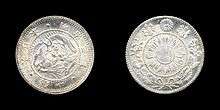
Design 1 - (1870)
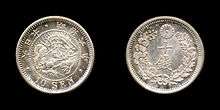
Design 2 - (1873–1906)

Design 3 - (1907–1912)[lower-alpha 1]
| Year of reign | Japanese date | Gregorian date | Mintage[6] |
|---|---|---|---|
| 3rd | 三 | 1870 Shallow scales | 6,102,674[15] |
| 3rd | 三 | 1870 Deep scales | |
| 6th | 六 | 1873[lower-alpha 2] | 5,109,951[4] |
| 7th | 七 | 1874 | 10,221,571[4] |
| 8th | 八 | 1875[lower-alpha 2] | 8,977,419[4] |
| 9th | 九 | 1876 | 11,890,000[4] |
| 10th | 十 | 1877 | 20,352,136[4] |
| 13th | 三十 | 1880 | 77[4] |
| 18th | 八十 | 1885 | 9,763,333[4] |
| 20th | 十二 | 1887 | 10,421,616[4] |
| 21st | 一十二 | 1888 | 8,177,229[4] |
| 24th | 四十二 | 1891 | 5,000,000[4] |
| 25th | 五十二 | 1892 | 5,000,000[4] |
| 26th | 六十二 | 1893 | 12,000,000[4] |
| 27th | 七十二 | 1894 | 11,000,000[4] |
| 28th | 八十二 | 1895 | 13,719,054[4] |
| 29th | 九十二 | 1896 | 15,080,506[4] |
| 30th | 十三 | 1897 | 20,357,439[4] |
| 31st | 一十三 | 1898 | 13,643,001[4] |
| 32nd | 二十三 | 1899 | 26,216,579[4] |
| 33rd | 三十三 | 1900 | 8,183,421[4] |
| 34th | 四十三 | 1901 | 797,561 |
| 35th | 五十三 | 1902 | 1,204,439 |
| 37th | 七十三 | 1904 | 11,106,638 |
| 38th | 八十三 | 1905 | 34,182,194 |
| 39th | 九十三 | 1906 | 4,710,168 |
| 40th | 十四 | 1907 | 12,000,000 |
| 41st | 一十四 | 1908 | 12,273,239 |
| 42nd | 二十四 | 1909 | 20,279,846 |
| 43rd | 三十四 | 1910 | 20,339,816 |
| 44th | 四十四 | 1911 | 38,729,680 |
| 45th | 五十四 | 1912 | 10,755,009 |
Taishō
The following are circulation figures for ten sen coins that were minted between the 1st and the 15th (last) year of Taishō's reign. The dates all begin with the Japanese symbol 大正 (Taishō), followed by the year of his reign the coin was minted. Each coin is read clockwise from right to left, so in the example used below "四" would read as "year 4" or 1915. Ten sen coins dated year 7 (1918) are rare, one such coin in about uncirculated condition sold for $11,500 USD in 2011.[16]
- "Year" ← "Number representing year of reign" ← "Emperors name" (Ex: 年 ← 四 ← 正大)
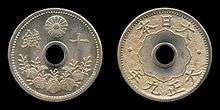
| Year of reign | Japanese date | Gregorian date | Mintage[6] |
|---|---|---|---|
| 1st | 元 | 1912 | 10,344,307 |
| 2nd | 二 | 1913 | 13,321,466 |
| 3rd | 三 | 1914 | 10,325,327 |
| 4th | 四 | 1915 | 16,836,225 |
| 5th | 五 | 1916 | 10,324,128 |
| 6th | 六 | 1917 | 35,170,906 |
| 9th | 九 | 1920 (New design) | 4,894,420 |
| 10th | 十 | 1921 | 61,870,000 |
| 11th | 一十 | 1922 | 159,770,000 |
| 12th | 二十 | 1923 | 190,010,000 |
| 14th | 四十 | 1925 | 54,475,000 |
| 15th | 五十 | 1926 | 58,675,000 |
Shōwa

Design 2 - (1933-1937)[lower-alpha 3]
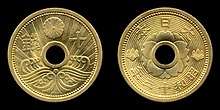
Design 3 - (1938-1940)
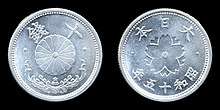
Design 4 - (1940-1943)

Design 5 - (1944)

Design 6 - (1945-1946)
The following are circulation figures for ten sen coins that were minted between the 2nd, and the 21st year of Emperor Shōwa's reign. The dates all begin with the Japanese symbol 昭和 (Shōwa), followed by the year of his reign the coin was minted. Each coin is read clockwise from right to left, so in the example used below "二十" would read as "year 12" or 1937. Coin patterns that include examples struck on porcelain are not included here as they were never issued for circulation. It is unknown how many unofficial locally made clay baked coins circulated.
- "Year" ← "Number representing year of reign" ← "Emperors name" (Ex: 年 ← 二十 ← 和昭)
| Year of reign | Japanese date | Gregorian date | Mintage[6] |
|---|---|---|---|
| 2nd | 二 | 1927 | 36,050,000 |
| 3rd | 三 | 1928 | 41,450,000 |
| 4th | 四 | 1929 | 10,050,000 |
| 6th | 六 | 1931 | 1,850,087 |
| 7th | 七 | 1932 | 23,151,177 |
| 8th | 八 | 1933 | 14,570,714 |
| 9th | 九 | 1934 | 37,351,832 |
| 10th | 十 | 1935 | 35,586,755 |
| 11th | 一十 | 1936 | 77,948,804 |
| 12th | 二十 | 1937 | 40,001,969 |
| 13th | 三十 | 1938 | 46,999,990 |
| 14th | 四十 | 1939 | 121,500,000 |
| 15th | 五十 | 1940 TY1 (AB) | 165,000,000 |
| 15th | 五十 | 1940 TY2 (AL) | 575,600,000 |
| 16th | 六十 | 1941 TY1 | |
| 16th | 六十 | 1941 TY2[lower-alpha 4] | 944,900,000 |
| 17th | 七十 | 1942 | |
| 18th | 八十 | 1943 | |
| 18th | 八十 | 1943 (Reduced weight) | 756,000,000 |
| 19th | 九十 | 1944 | 450,000,000 |
| 20th | 十二 | 1945 | 237,590,000 |
| 21st | 一十二 | 1946 |
Weight and size
| Minted | Size | Weight |
|---|---|---|
| 1870 | 17.57mm | 2.5g |
| 1873-1906 | 17.57mm | 2.7g |
| 1907-1917 | 17.57mm | 2.3g |
| 1920-1932 | 22.12mm | 3.8g |
| 1933-1940 | 22.00mm | 4.0g |
| 1940-1941 | 22.00mm | 1.5g |
| 1941-1943 | 22.00mm | 1.2g |
| 1943 | 22.00mm | 1.0g |
| 1944 | 19.00mm | 2.4g |
| 1945-1946 | 22.00mm | 1.0g |
Notes
- The third silver based design was also used during Taishō's reign until 1918, when the alloy was adjusted.
- Two different types were made this year, their mintage is combined.
- The first design is shown above under "Taishō".
- Ten sen coins were minted in 1941 with weights of 1.5g, and 1.2g creating two different types for the year.
References
- "Japan 5, 10, 20, 50 Sen and 1 Yen (Fakes are possible) 1873 to 1900". www.coinquest.com. Archived from the original on 2016-09-10. Retrieved August 30, 2016.
- John Crowdy. "The British Almanac". Stationers' Company. p. 112-113. Retrieved December 9, 2016.
- "小額通貨の整理及び支払金の端数計算に関する法律" [A law of the abolition of currencies in a small denomination and rounding off a fraction, July 15, 1953 Law No.60]. www.shugiin.go.jp. Archived from the original on June 28, 2002. Retrieved December 5, 2016.
- "Japan 10 Sen Y#23 Yr.10(1877)-Yr.9(1876)". Numismatic Guaranty Corporation. Retrieved December 1, 2016.
- "10銭銀貨" (in Japanese). www.buntetsu.net. Retrieved December 2, 2016.
- Chester L. Krause & Clifford Mishler. Collecting World Coins 10th edition. Krause Publications. p. 430-431.
- "Japan 10 Sen KM# Pn45 Yr.7 (1918)". Numismatic Guaranty Corporation. Retrieved December 1, 2016.
- Chester L. Krause & Clifford Mishler. Collecting World Coins 10th edition. Krause Publications. p. 431.
- "10銭白銅貨" (in Japanese). www.buntetsu.net. Retrieved December 2, 2016.
- "10銭ニッケル貨" (in Japanese). www.buntetsu.net. Retrieved December 2, 2016.
- "10銭アルミニウム青銅貨" (in Japanese). www.buntetsu.net. Retrieved December 2, 2016.
- "10銭アルミニウム貨" (in Japanese). www.buntetsu.net. Retrieved December 2, 2016.
- "10銭錫貨" (in Japanese). www.buntetsu.net. Retrieved December 2, 2016.
- "10銭アルミニウム貨" (in Japanese). www.buntetsu.net. Retrieved December 2, 2016.
- "Japan 10 Sen Y# 2 Yr.3(1870)". Numismatic Guaranty Corporation. Retrieved December 1, 2016.
- "T7(1918) JAPAN KM-PN45 SILVER 10S MS Coin Auctions". Numismatic Guaranty Corporation. Retrieved December 1, 2016.
